Forefront Users’ Experience Evaluation by Employing Together Virtual Reality and Electroencephalography: A Case Study on Cognitive Effects of Scents
Abstract
1. Introduction
1.1. Virtual Reality: A Realistic Experience Preserving a High Ecological Validity
1.2. The Power of Scents
1.3. Neurophysiological Evaluation of User’s Experience
1.4. The Case Study
2. Materials and Methods
2.1. Participants
2.2. Experimental Groups
2.3. Experimental Protocol
2.3.1. VR Training and Train Choice
2.3.2. VR Neutral Environment (Baseline)
2.3.3. VR Train Journey
2.3.4. Questionnaire
2.3.5. Data Recording and Signal Processing
2.3.6. Performed Analysis
3. Results
3.1. Mental Effort
3.2. Self-Reported Smell Awareness and Smell Identification by Name
3.3. Self-Reported Pleasantness and Involvement
3.4. Self-Reported Audio Perception (Involvement, Identification, Localization)
4. Discussion
4.1. Summary
4.2. Recommendations for Future Experimental Studies
5. Conclusions
Author Contributions
Funding
Institutional Review Board Statement
Informed Consent Statement
Data Availability Statement
Conflicts of Interest
References
- Unity Real-Time Development Platform|3D, 2D VR & AR Engine. Available online: https://unity.com (accessed on 1 February 2021).
- The Most Powerful Real-Time 3D Creation Platform-Unreal Engine. Available online: https://www.unrealengine.com/en-US (accessed on 1 February 2021).
- Edler, D.; Keil, J.; Wiedenlübbert, T.; Sossna, M.; Kühne, O.; Dickmann, F. Immersive VR experience of redeveloped post-industrial sites: The example of ‘Zeche Holland’ in Bochum-Wattenscheid. KN J. Cartogr. Geogr. Inf. 2019, 69, 267–284. [Google Scholar] [CrossRef]
- Hruby, F.; Castellanos, I.; Ressl, R. Cartographic scale in immersive virtual environments. KN J. Cartogr. Geogr. Inf. 2020, 2020, 1–7. [Google Scholar] [CrossRef]
- Bohil, C.J.; Alicea, B.; Biocca, F.A. Virtual reality in neuroscience research and therapy. Nat. Rev. Neurosci. 2011, 12, 752–762. [Google Scholar] [CrossRef]
- Romano, D.M. Virtual reality therapy. Dev. Med. Child Neurol. 2005, 47, 580. [Google Scholar] [CrossRef]
- Rizzo, A.; Parsons, T.D.; Lange, B.; Patrick, K.; Buckwalter, J.G.; Rothbaum, B.; Difede, J.; Frazier, J.; Newman, B.; Williams, J.; et al. Virtual reality goes to war: A brief review of the future of military behavioral healthcare. J. Clin. Psychol. Med. Settings 2011, 18, 176–187. [Google Scholar] [CrossRef] [PubMed]
- Meehan, M.; Insko, B.; Whitton, M.; Brooks, F.P. Physiological measures of presence in stressful virtual environments. In Proceedings of the 29th ACM SIGGRAPH ’02, San Antonio, TX, USA, 14 July 2002; pp. 645–652. [Google Scholar]
- Riva, G.; Mantovani, F.; Capideville, C.S.; Preziosa, A.; Morganti, F.; Villani, D.; Gaggioli, A.; Botella, C.; Alcaniz, M. Affective interactions using virtual reality: The link between presence and emotions. Cyberpsychol. Behav. 2007, 10, 45–56. [Google Scholar] [CrossRef] [PubMed]
- Slater, M. Measuring presence: A response to the Witmer and Singer presence questionnaire. Presence 1999, 8, 560–565. [Google Scholar] [CrossRef]
- Diemer, J.; Alpers, G.W.; Peperkorn, H.M.; Shiban, Y.; Mühlberger, A. The impact of perception and presence on emotional reactions: A review of research in virtual reality. Front. Psychol. 2015, 6, 26. [Google Scholar] [CrossRef]
- Serrano, B.; Botella, C.; Baños, R.M.; Alcañiz, M. Using virtual reality and mood-induction procedures to test products with consumers of ceramic tiles. Comput. Human Behav. 2013, 29, 648–653. [Google Scholar] [CrossRef]
- Baños, R.M.; Botella, C.; Alcañiz, M.; Liaño, V.; Guerrero, B.; Rey, B. Immersion and emotion: Their impact on the sense of presence. Cyberpsychology Behav. 2004, 7, 734–741. [Google Scholar] [CrossRef]
- Borba, E.Z.; Zuffo, M.K. Advertising perception with immersive virtual reality devices. In Proceedings of the 2017 IEEE Virtual Reality (VR), Los Angeles, CA, USA, 18–22 March 2017; pp. 371–372. [Google Scholar]
- Seth, K.; Suzuki, K.; Critchley, H.D. An interoceptive predictive coding model of conscious presence. Front. Psychol. 2012, 3, 1–16. [Google Scholar] [CrossRef]
- Isdale, J. What is Virtual Reality. Virtual Real. Inf. Resour. 1998, 4. Available online: http://www.columbia.edu/~rk35/vr/vr.html (accessed on 17 February 2021).
- HTC Vive Pro Sees Permanent Price Drop Starting from £599–VRFocus. Available online: https://www.vrfocus.com/2020/01/htc-vive-pro-sees-permanent-price-drop-starting-from-599 (accessed on 7 June 2020).
- Oculus Price Drop–VR.org. Available online: https://www.vr.org/tag/oculus-price-drop (accessed on 7 June 2020).
- Pallavicini, F.; Pepe, A.; Ferrari, A.; Garcea, G.; Zanacchi, A.; Mantovani, F. What Is the Relationship Among Positive Emotions, Sense of Presence, and Ease of Interaction in Virtual Reality Systems? An On-Site Evaluation of a Commercial Virtual Experience. Presence Virtual Augment. Real. 2020, 27, 183–201. [Google Scholar] [CrossRef]
- Estupiñán, S.; Rebelo, F.; Noriega, P.; Ferreira, C.; Duarte, E. Can virtual reality increase emotional responses (Arousal and Valence)? A pilot study. In Proceedings of the International Conference of Design, User Experience, and Usability, Crete, Greece, 22–27 June 2014; pp. 541–549. [Google Scholar]
- Mehrabian, A.; Russell, J.A. An Approach to Environmental Psychology; MIT Press: Cambridge, MA, USA, 1974. [Google Scholar]
- Pinto, J.M. Olfaction. Proc. Am. Thorac. Soc. 2011, 8, 46–52. [Google Scholar] [CrossRef]
- Gazzaniga, M.S. The Cognitive Neurosciences; MIT Press: Cambridge, MA, USA, 2009. [Google Scholar]
- Making Sense of Scents: Smell and the Brain. Available online: https://www.brainfacts.org/thinking-sensing-and-behaving/smell/2015/making-sense-of-scents-smell-and-the-brain (accessed on 7 June 2020).
- Winston, J.S.; Gottfried, J.A.; Kilner, J.M.; Dolan, R.J. Integrated neural representations of odor intensity and affective valence in human amygdala. J. Neurosci. 2005, 25, 8903–8907. [Google Scholar] [CrossRef]
- Fortin, N.J.; Agster, K.L.; Eichenbaum, H.B. Critical role of the hippocampus in memory for sequences of events. Nat. Neurosci. 2002, 5, 458–462. [Google Scholar] [CrossRef]
- Epple, G.; Herz, R.S. Ambient odors associated to failure influence cognitive performance in children. Dev. Psychobiol. J. Int. Soc. Dev. Psychobiol. 1999, 35, 103–107. [Google Scholar] [CrossRef]
- Spence, C. Gastrophysics: The New Science of Eating; Penguin: London, UK, 2017. [Google Scholar]
- Bestgen, A.K.; Schulze, P.; Kuchinke, L. Odor emotional quality predicts odor identification. Chem. Senses 2015, 40, 517–523. [Google Scholar] [CrossRef]
- Jiang, H.; Schuele, S.; Rosenow, J.; Zelano, C.; Parvizi, J.; Tao, J.X.; Wu, S.; Gottfried, J.A. Theta oscillations rapidly convey odor-specific content in human piriform cortex. Neuron 2017, 94, 207–219. [Google Scholar] [CrossRef]
- Burnett, K.M.; Solterbeck, L.A.; Strapp, C.M. Scent and mood state following an anxiety-provoking task. Psychol. Rep. 2004, 95, 707–722. [Google Scholar] [CrossRef]
- di Flumeri, G.; Herrero, M.T.; Trettel, A.; Cherubino, P.; Maglione, A.G.; Colosimo, A.; Moneta, E.; Peparaio, M.; Babiloni, F. EEG frontal asymmetry related to pleasantness of olfactory stimuli in young subjects. In Selected Issues in Experimental Economics; Springer: Berlin/Heidelberg, Germany, 2016; pp. 373–381. [Google Scholar]
- Davidson, R.J.; Ekman, P.; Saron, C.D.; Senulis, J.A.; Friesen, W.V. Approach-withdrawal and cerebral asymmetry: Emotional expression and brain physiology: I. J. Pers. Soc. Psychol. 1990, 58, 330. [Google Scholar] [CrossRef]
- Sutton, S.K.; Davidson, R.J. Prefrontal brain asymmetry: A biological substrate of the behavioral approach and inhibition systems. Psychol. Sci. 1997, 8, 204–210. [Google Scholar] [CrossRef]
- di Flumeri, G.; Herrero, M.T.; Trettel, A.; Cherubino, P.; Maglione, A.G.; Colosimo, A.; Moneta, E.; Peparaio, M.; Babiloni, F. EEG-based approach-withdrawal index for the pleasantness evaluation during taste experience in realistic settings. In Proceedings of the 2017 39th Annual International Conference of the IEEE Engineering in Medicine and Biology Society (EMBC), Jeju, Korea, 11–15 July 2017; pp. 3228–3231. [Google Scholar]
- Kim, M.H. Comparison of Psychological and Physiological Differences of Human due to the EEG Type Scent. J. Korea Acad. Coop. Soc. 2013, 14, 418–425. [Google Scholar]
- Lee, I. Effects of inhalation of relaxing essential oils on electroencephalogram activity. Int. J. New Technol. Res. 2016, 2, 5. [Google Scholar]
- Bosmans, A. Scents and sensibility: When do (in) congruent ambient scents influence product evaluations? J. Mark. 2006, 70, 32–43. [Google Scholar] [CrossRef]
- Carulli, M.; Bordegoni, M.; Cugini, U. Integrating Scents Simulation in Virtual Reality Multisensory Environment for Industrial Products Evaluation. Comput. Aided. Des. Appl. 2016, 13, 320–328. [Google Scholar] [CrossRef]
- Bonini, N.; Graffeo, M.; Hadjichristidis, C.; Perrotta, V. The effects of incidental scents in the evaluation of environmental goods: The role of congruity. PsyCh J. 2015, 4, 66–73. [Google Scholar] [CrossRef]
- Bradford, D.; Desrochers, D.M. The use of scents to influence consumers: The sense of using scents to make cents. J. Bus. Ethics 2009, 90, 141–153. [Google Scholar] [CrossRef]
- Spangenberg, E.R.; Crowley, A.E.; Henderson, P.W. Improving the store environment: Do olfactory cues affect evaluations and behaviors? J. Mark. 1996, 60, 67–80. [Google Scholar] [CrossRef]
- de Luca, R.; Botelho, D. The unconscious perception of smells as a driver of consumer responses: A framework integrating the emotion-cognition approach to scent marketing. AMS Rev. 2019, 1–17. [Google Scholar] [CrossRef]
- Germine, L.; Reinecke, K.; Chaytor, N.S. Digital neuropsychology: Challenges and opportunities at the intersection of science and software. Clin. Neuropsychol. 2019, 33, 271–286. [Google Scholar] [CrossRef]
- Chai, J.; Ge, Y.; Liu, Y.; Li, W.; Zhou, L.; Yao, L.; Sun, X. Application of frontal EEG asymmetry to user experience research. Lect. Notes Comput. Sci. 2014, 8532, 234–243. [Google Scholar]
- Aricò, P.; Borghini, G.; di Flumeri, G.; Sciaraffa, N.; Babiloni, F. Passive BCI beyond the lab: Current trends and future directions. Physiol. Meas. 2018, 39, 8. [Google Scholar] [CrossRef]
- Arico, P.; Borghini, G.; di Flumeri, G.; Sciaraffa, N.; Colosimo, A.; Babiloni, F. Passive BCI in operational environments: Insights, recent advances, and future trends. IEEE Trans. Biomed. Eng. 2017, 64, 1431–1436. [Google Scholar] [CrossRef] [PubMed]
- di Flumeri, S.G.; Aricò, P.; Sciaraffa, N.; Babiloni, F.; Borghini, G. Neurophysiological vigilance characterisation and assessment: Laboratory and realistic validations involving professional air traffic controllers. Brain Sci. 2020, 10, 48. [Google Scholar]
- Borghini, G.; di Flumeri, G.; Arcio, P.; Sciaragga, N.; Bonelli, S.; Ragosta, M.; Tomasello, P.; Drogoul, F.; Turhan, U.; Acikel, B.; et al. A multimodal and signals fusion approach for assessing the impact of stressful events on Air Traffic Controllers. Sci. Rep. 2020, 10, 1–18. [Google Scholar] [CrossRef]
- Borghini, G.; di Flumeri, G.; Arcio, P.; Sciaragga, N.; Bonelli, S.; Ragosta, M.; Tomasello, P.; Drogoul, F.; Turhan, U.; Acikel, B.; et al. EEG-based cognitive control behaviour assessment: An ecological study with professional air traffic controllers. Sci. Rep. 2017, 7, 1–16. [Google Scholar] [CrossRef]
- Toppi, J.; Borghini, G.; Petti, M.; He, E.J.; De Giusti, V.; He, B.; Astolfi, L.; Babiloni, F. Investigating cooperative behavior in ecological settings: An EEG hyperscanning study. PLoS ONE 2016, 11, 4236. [Google Scholar] [CrossRef] [PubMed]
- Wang, C.H.; Moreau, D.; Kao, S.C. From the lab to the field: The potential applications of dry EEG systems to understand brain-behavior relationship in sports. Front. Neurosci. 2019, 13, 893. [Google Scholar] [CrossRef] [PubMed]
- di Flumeri, G.; Aricò, P.; Borghini, G.; Sciaraffa, N.; di Florio, A.; Babiloni, F. The dry revolution: Evaluation of three different EEG dry electrode types in terms of signal spectral features, mental states classification and usability. Sensors 2019, 19, 1365. [Google Scholar] [CrossRef]
- Krol, R.; Freytag, S.C.; Zander, T.O. Meyendtris: A hands-free, multimodal tetris clone using eye tracking and passive BCI for intuitive neuroadaptive gaming. In Proceedings of the 19th ACM International Conference on Multimodal Interaction, Glasglow, Scotland, 13–17 November 2017; pp. 433–437. [Google Scholar]
- Ewing, K.C.; Fairclough, S.H.; Gilleade, K. Evaluation of an adaptive game that uses EEG measures validated during the design process as inputs to a biocybernetic loop. Front. Hum. Neurosci. 2016, 10, 223. [Google Scholar] [CrossRef] [PubMed]
- Naumann, L.; Kraft, S.M.; Dähne, S.; Blankertz, B. Prediction of difficulty levels in video games from ongoing EEG. In International Workshop on Symbiotic Interaction; Springer: Cham, Switzerland, 2016; pp. 125–136. [Google Scholar]
- Ariely, D.; Berns, G.S. Neuromarketing: The hope and hype of neuroimaging in business. Nat. Rev. Neurosci. 2010, 11, 284–292. [Google Scholar] [CrossRef]
- Davidson, R.J. What does the prefrontal cortex ‘do’ in affect: Perspectives on frontal EEG asymmetry research. Biol. Psychol. 2004, 67, 219–234. [Google Scholar] [CrossRef]
- Cherubino, P.; Martinez, L.A.C.; Caratu, M.; Cartocci, G.; Di Flumeri, G.; Modica, E.; Rossi, D.; Mancini, M.; Trettel, A. Consumer behaviour through the eyes of neurophysiological measures: State-of-the-art and future trends. Comput. Intell. Neurosci. 2019, 2019. [Google Scholar] [CrossRef] [PubMed]
- Vecchiato, G.; Toppi, J.; Astolfi, L.; De Fallani, F.V.; Cincotti, F.; Mattia, D.; Bez, F.; Babiloni, F. Spectral EEG frontal asymmetries correlate with the experienced pleasantness of TV commercial advertisements. Med. Biol. Eng. Comput. 2011, 49, 579–583. [Google Scholar] [CrossRef]
- Vecchiato, G.; Kong, W.; Maglione, A.G.; Wei, D. Understanding the impact of TV commercials. IEEE Pulse 2012, 3, 42. [Google Scholar] [CrossRef] [PubMed]
- Vecchiato, G.; Cherubino, P.; Trettel, A.; Babiloni, F. Neuroelectrical Brain Imaging Tools for the Study of the Efficacy of TV Advertising Stimuli and their Application to Neuromarketing; Springer: Heidelberg/Berlin, Germany, 2013. [Google Scholar]
- Vecchiato, G.; Toppi, J.; Astolfi, L.; De Fallani, F.V.; Cincotti, F.; Mattia, D.; Bez, F.; Babiloni, F. An electroencephalographic Peak Density Function to detect memorization during the observation of TV commercials. In Proceedings of the 2014 36th Annual International Conference of the IEEE Engineering in Medicine and Biology Society, Chicago, IL, USA, 26–30 August 2014; pp. 6969–6972. [Google Scholar]
- Cartocci, G.; Cherubino, P.; Rossi, D.; Modica, E.; Maglione, A.G.; di Flumeri, G.; Babiloni, F. Gender and age related effects while watching TV advertisements: An EEG study. Comput. Intell. Neurosci. 2016. [Google Scholar] [CrossRef] [PubMed]
- Cartocci, G.; Cherubino, P.; Rossi, D.; Modica, E.; Maglione, A.G.; di Flumeri, G.; Babiloni, F. The ‘NeuroDante project’: Neurometric measurements of participant’s reaction to literary auditory stimuli from Dante’s Divina Commedia. In International Workshop on Symbiotic Interaction; Springer: Cham, Switzerland, 2016; pp. 52–64. [Google Scholar]
- Cherubino, P.; Trettel, A.; Cartocci, G.; Rossi, D.; Modica, E.; Maglione, A.G.; Mancini, M.; di Flumeri, G.; Babiloni, F. Neuroelectrical indexes for the study of the efficacy of TV advertising stimuli. In Selected Issues in Experimental Economics; Springer: Heidelberg/Berlin, Germany, 2016; pp. 355–371. [Google Scholar]
- Marsella, P.; Scorpecci, A.; Cartocci, G.; Giannantonio, S.; Maglione, A.G.; Venuti, I.; Brizi, A.; Babiloni, F. EEG activity as an objective measure of cognitive load during effortful listening: A study on pediatric subjects with bilateral, asymmetric sensorineural hearing loss. Int. J. Pediatr. Otorhinolaryngol. 2017, 99, 1–7. [Google Scholar] [CrossRef] [PubMed]
- Abbasi, N.I.; Bose, R.; Bezerianos, A.; Thakor, N.V.; Dragomir, A. EEG-Based Classification of Olfactory Response to Pleasant Stimuli. In Proceedings of the 2019 41st Annual International Conference of the IEEE Engineering in Medicine and Biology Society (EMBC), Berlin, Germany, 23–27 July 2019; pp. 5160–5163. [Google Scholar]
- Songsamoe, S.; Saengwongngam, R.; Koomhin, P.; Matan, N. Understanding consumer physiological and emotional responses to food products using Electroencephalography (EEG). Trends Food Sci. Technol. 2019, 93, 167–173. [Google Scholar] [CrossRef]
- Ellen, S.; Bone, P.F. Does it matter if it smells? Olfactory stimuli as advertising executional cues. J. Advert. 1998, 27, 29–39. [Google Scholar] [CrossRef]
- Sarid, O.; Zaccai, M. Changes in mood states are induced by smelling familiar and exotic fragrances. Front. Psychol. 2016, 7, 1724. [Google Scholar] [CrossRef] [PubMed]
- Glaser, K.J.K.; Graham, J.E.; Malarkey, W.B.; Porter, K.; Lemeshow, S.; Glaser, R. Olfactory influences on mood and autonomic, endocrine, and immune function. Psychoneuroendocrinology 2008, 33, 328–339. [Google Scholar] [CrossRef]
- Gaggioli, A.; Bassi, M.; Fave, A.D. Quality of experience in virtual environments. Emerg. Commun. 2003, 5, 121–136. [Google Scholar]
- Matheis, J.; Schultheis, M.T.; Tiersky, L.A.; DeLuca, J.; Millis, S.R.; Rizzo, A. Is learning and memory different in a virtual environment? Clin. Neuropsychol. 2007, 21, 146–161. [Google Scholar] [CrossRef] [PubMed]
- Jovanovski, D.; Zakzanis, K.; Campbell, Z.; Erb, S.; Nussbaum, D. Development of a novel, ecologically oriented virtual reality measure of executive function: The Multitasking in the City Test. Appl. Neuropsychol. Adult 2012, 19, 171–182. [Google Scholar] [CrossRef] [PubMed]
- Campbell, Z.; Zakzanis, K.K.; Jovanovski, D.; Joordens, S.; Mraz, R.; Graham, S.J. Utilizing virtual reality to improve the ecological validity of clinical neuropsychology: An FMRI case study elucidating the neural basis of planning by comparing the Tower of London with a three-dimensional navigation task. Appl. Neuropsychol. 2009, 16, 295–306. [Google Scholar] [CrossRef]
- Holland, W.; Hendriks, M.; Aarts, H. Smells like clean spirit: Nonconscious effects of scent on cognition and behavior. Psychol. Sci. 2005, 16, 689–693. [Google Scholar] [CrossRef] [PubMed]
- Kapustová, Z.; Horská, E.; Bercik, J.; Paluchová, J.; Gurčík, Ľ. The importance of odours in the workplace: A review. Stud. Mundi Econ. 2018, 5, 97–104. [Google Scholar]
- Berka, C.; Levendowski, D.J.; Lumicao, M.N.; Yau, A.; Davis, G.; Zivkovic, V.T.; Richard, E.; Tremoulet, P.D.; Craven, P.L. EEG correlates of task engagement and mental workload in vigilance, learning, and memory tasks. Aviat. Space. Environ. Med. 2007, 78, B231–B244. [Google Scholar] [PubMed]
- Borghini, G.; di Flumeri, G.; Arcio, P.; Sciaragga, N.; Bonelli, S.; Ragosta, M.; Tomasello, P.; Drogoul, F.; Turhan, U.; Acikel, B.; et al. Frontal EEG theta changes assess the training improvements of novices in flight simulation tasks. In Proceedings of the 2013 35th Annual International Conference of the IEEE Engineering in Medicine and Biology Society (EMBC), Guadalajara, Mexico, October 31–4 November 2013; pp. 6619–6622. [Google Scholar]
- di Flumeri, G.; Aricò, P.; Sciaraffa, N.; Babiloni, F.; Borghini, G. EEG-based mental workload neurometric to evaluate the impact of different traffic and road conditions in real driving settings. Front. Hum. Neurosci. 2018, 12, 509. [Google Scholar] [CrossRef]
- Borghini, G.; Astolfi, L.; Vecchiato, G.; Mattia, D.; Babiloni, F. Measuring neurophysiological signals in aircraft pilots and car drivers for the assessment of mental workload, fatigue and drowsiness. Neurosci. Biobehav. Rev. 2014, 4, 58–75. [Google Scholar] [CrossRef]
- Brookings, J.B.; Wilson, G.F.; Swain, C.R. Psychophysiological responses to changes in workload during simulated air traffic control. Biol. Psychol. 1996, 42, 361–377. [Google Scholar] [CrossRef]
- Aricò, P.; Borghini, G.; di Flumeri, G.; Colosimo, A.; Pozzi, S.; Babiloni, F. A passive brain–computer interface application for the mental workload assessment on professional air traffic controllers during realistic air traffic control tasks. In Progress in Brain Research; Elsevier: Amsterdam, The Netherlands, 2016; Volume 228, pp. 295–328. [Google Scholar]
- Aricò, P.; Borghini, G.; Di Flumeri, G.; Bonelli, S.; Golfetti, A.; Graziani, I.; Pozzi, S.; Imbert, K.P.; Granger, G.; Benhacene, R.; et al. Human factors and neurophysiological metrics in air traffic control: A critical review. IEEE Rev. Biomed. Eng. 2017, 10, 250–263. [Google Scholar]
- Brinkmann, M. Relation between Working Memory Capacity and Frontal-Midline Theta Increase in the Sternberg Task; University of Twente: Drienerlolaan, The Netherlands, 2019. [Google Scholar]
- Lin, C.L.; Jung, M.; Wu, Y.C.; Lin, C.T.; She, H.C. Brain dynamics of mathematical problem solving. In Proceedings of the 2012 Annual International Conference of the IEEE Engineering in Medicine and Biology Society, San Diego, CA, USA, 28 August–1 September 2012; pp. 4768–4771. [Google Scholar]
- Cartocci, G.; Cherubino, P.; Rossi, D.; Modica, E.; Maglione, A.G.; di Flumeri, G.; Babiloni, F. Neurophysiological Measures of the Perception of Antismoking Public Service Announcements Among Young Population. Front. Hum. Neurosci. 2018, 12, 1–17. [Google Scholar] [CrossRef] [PubMed]
- Wascher, E.; Rasch, B.; Sanger, J.; Hoffmann, S.; Schneider, D.; Rinkenauer, G.; Heuer, H.; Gutberlet, I. Frontal theta activity reflects distinct aspects of mental fatigue. Biol. Psychol. 2014, 96, 57–65. [Google Scholar] [CrossRef]
- Middleton, J. Midfrontal Theta and Cognitive Effort: Real World Applications in Medical Decision-Making; University of Victoria: Victoria, BC, Canada, 2019. [Google Scholar]
- Chang, E.; Kim, H.T.; Yoo, B. Virtual Reality Sickness: A Review of Causes and Measurements. Int. J. Hum. Comput. Interact. 2020, 36, 1658–1682. [Google Scholar] [CrossRef]
- Dużmańska, N.; Strojny, P.; Strojny, A. Can simulator sickness be avoided? A review on temporal aspects of simulator sickness. Front. Psychol. 2018, 9, 2132. [Google Scholar] [CrossRef]
- Belouchrani, A.; Abed-Meraim, K.; Cardoso, J.F.; Moulines, E. A blind source separation technique using second-order statistics. IEEE Trans. Signal Process. 1997, 45, 434–444. [Google Scholar] [CrossRef]
- di Flumeri, G.; Aricó, P.; Borghini, G.; Colosimo, A.; Babiloni, F. A new regression-based method for the eye blinks artifacts correction in the EEG signal, without using any EOG channel. In Proceedings of the 2016 38th Annual International Conference of the IEEE Engineering in Medicine and Biology Society (EMBC), Orlando, FL, USA, 16–20 August 2016; pp. 3187–3190. [Google Scholar]
- Delorme, A.; Makeig, S. EEGLAB: An open source toolbox for analysis of single-trial EEG dynamics including independent component analysis. J. Neurosci. Methods 2004, 134, 9–21. [Google Scholar] [CrossRef]
- Chapter 01: Rejecting Artifacts-SCCN. Available online: https://sccn.ucsd.edu/wiki/Chapter_01:_Rejecting_Artifacts (accessed on 30 December 2020).
- di Flumeri, G.; Aricò, P.; Sciaraffa, N.; Babiloni, F.; Borghini, G. Brain-computer interface-based adaptive automation to prevent out-of-the-loop phenomenon in air traffic controllers dealing with highly automated systems. Front. Hum. Neurosci. 2019, 13, 296. [Google Scholar] [CrossRef]
- Aricò, P.; Borghini, G.; di Flumeri, G.; Babiloni, F. Method for Estimating a Mental State. Part. A Workload. Relat. Appar. U.S. Patent EP3143933A1, 22 March 2017. [Google Scholar]
- Klimesch, W. EEG alpha and theta oscillations reflect cognitive and memory performance: A review and analysis. Brain Res. Rev. 1999, 29, 169–195. [Google Scholar] [CrossRef]
- Lehmann, D.; Michel, C.M. Intracerebral dipole source localization for FFT power maps. Electroencephalogr. Clin. Neurophysiol. 1990, 76, 271–276. [Google Scholar] [CrossRef]
- Skrandies, W. Contrast and stereoscopic visual stimuli yield lateralized scalp potential fields associated with different neural generators. Electroencephalogr. Clin. Neurophysiol. 1991, 78, 274–283. [Google Scholar] [CrossRef]
- Ahonen, L.; Huotilainen, M.; Brattico, E. Within-and between-session replicability of cognitive brain processes: An MEG study with an N-back task. Physiol. Behav. 2016, 158, 43–53. [Google Scholar] [CrossRef]
- Giroud, N.; Lemke, U.; Reich, P.; Matthes, K.L.; Meyer, M. The impact of hearing aids and age-related hearing loss on auditory plasticity across three months–An electrical neuroimaging study. Hear. Res. 2017, 353, 162–175. [Google Scholar] [CrossRef]
- Maurer, K.; Dierks, T.; Strik, W.K.; Frölich, L. P3 topography in psychiatry and psychopharmacology. Brain Topogr. 1990, 3, 79–84. [Google Scholar] [CrossRef]
- Skrandies, W. Global field power and topographic similarity. Brain Topogr. 1990, 3, 137–141. [Google Scholar] [CrossRef]
- Wisniewski, M.G.; Thompson, E.R.; Iyer, N.; Estepp, J.R.; Reiser, G.M.N.; Sullivan, S.C. Frontal midline θ power as an index of listening effort. Neuroreport 2015, 26, 94–99. [Google Scholar] [CrossRef]
- Sayorwan, W.; Siripornpanich, V.; Piriyapunyaporn, T.; Hongratanaworakit, T.; Kotchabhakdi, N.; Ruangrungsi, N. The Effects of Lavender Oil Inhalation on Emotional States, Autonomic Nervous System, and Brain Electrical Activity; Chulalongkorn University: Bongkok, Thailand, 2012. [Google Scholar]
- Degel, J.; Köster, E.P. Odors: Implicit memory and performance effects. Chem. Senses 1999, 24, 317–325. [Google Scholar] [CrossRef]
- Cruz, B.; Seung, E.L.; Pagaduan, J.C.; Tae, H.K. Effects of lavender (Lavandula angustifolia Mill.) and peppermint (Mentha cordifolia Opiz.) aromas on subjective vitality, speed and agility. Asia Life Sci. 2012, 21, 31–37. [Google Scholar]
- Diego, M.A.; Jones, N.A.; Field, T.; Hernandez-reif, M.; Schanberg, S.; Kuhn, C.; Galamaga, M.; McAdam, V.; Galamaga, R. Aromatherapy positively affects mood, EEG patterns of alertness and math computations. Int. J. Neurosci. 1998, 96, 217–224. [Google Scholar] [CrossRef] [PubMed]
- Field, T.; Diego, M.; Hernandez, R.M.; Cisneros, W.; Feijo, L.; Vera, Y.; Gil, K.; Grina, D.; He, C.Q. Lavender fragrance cleansing gel effects on relaxation. Int. J. Neurosci. 2005, 115, 207–222. [Google Scholar]
- Sakamoto, R.; Minoura, K.; Usui, A.; Ishizuka, Y.; Kanba, S. Effectiveness of aroma on work efficiency: Lavender aroma during recesses prevents deterioration of work performance. Chem. Senses 2005, 30, 683–691. [Google Scholar] [CrossRef] [PubMed]
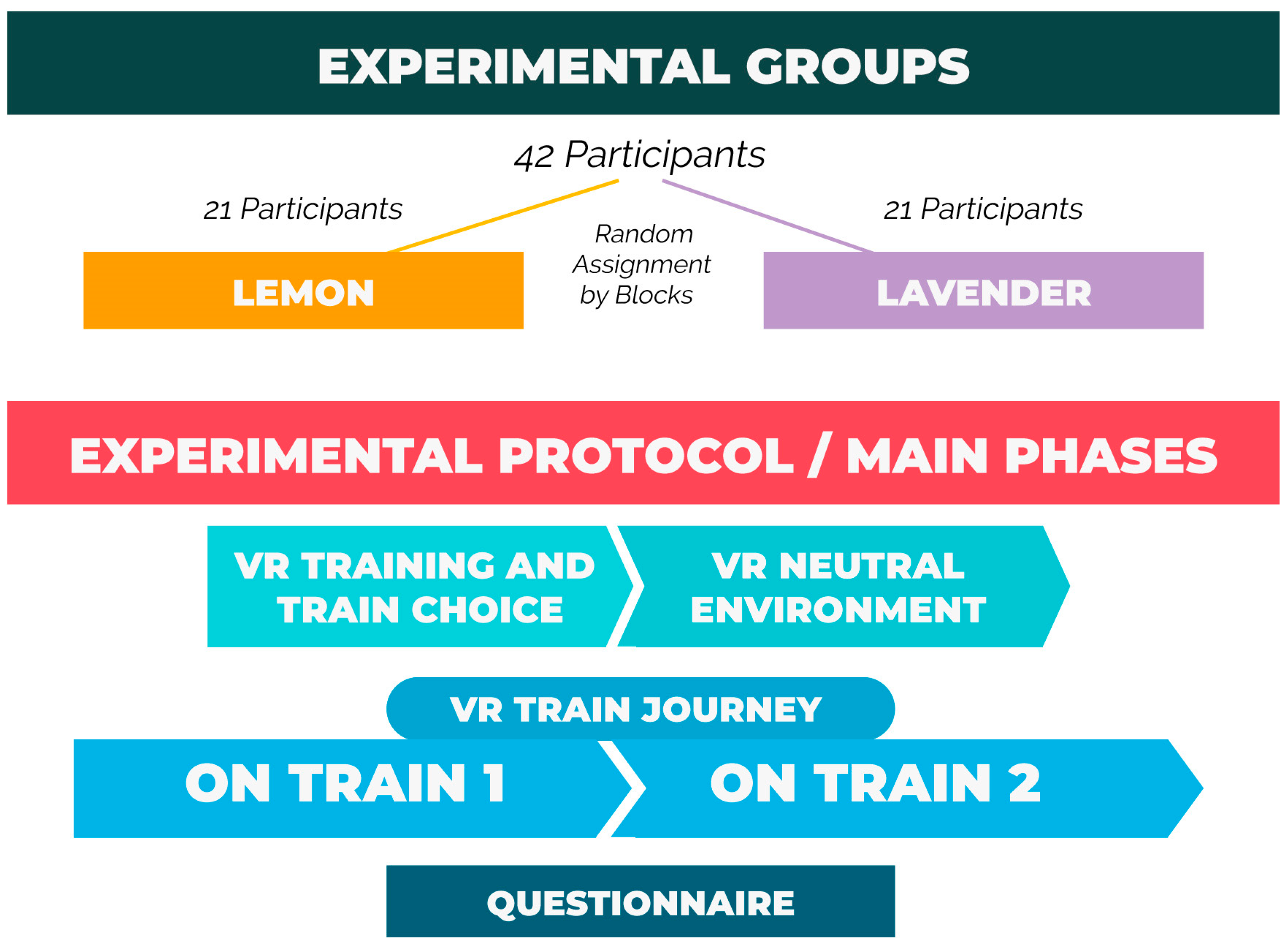

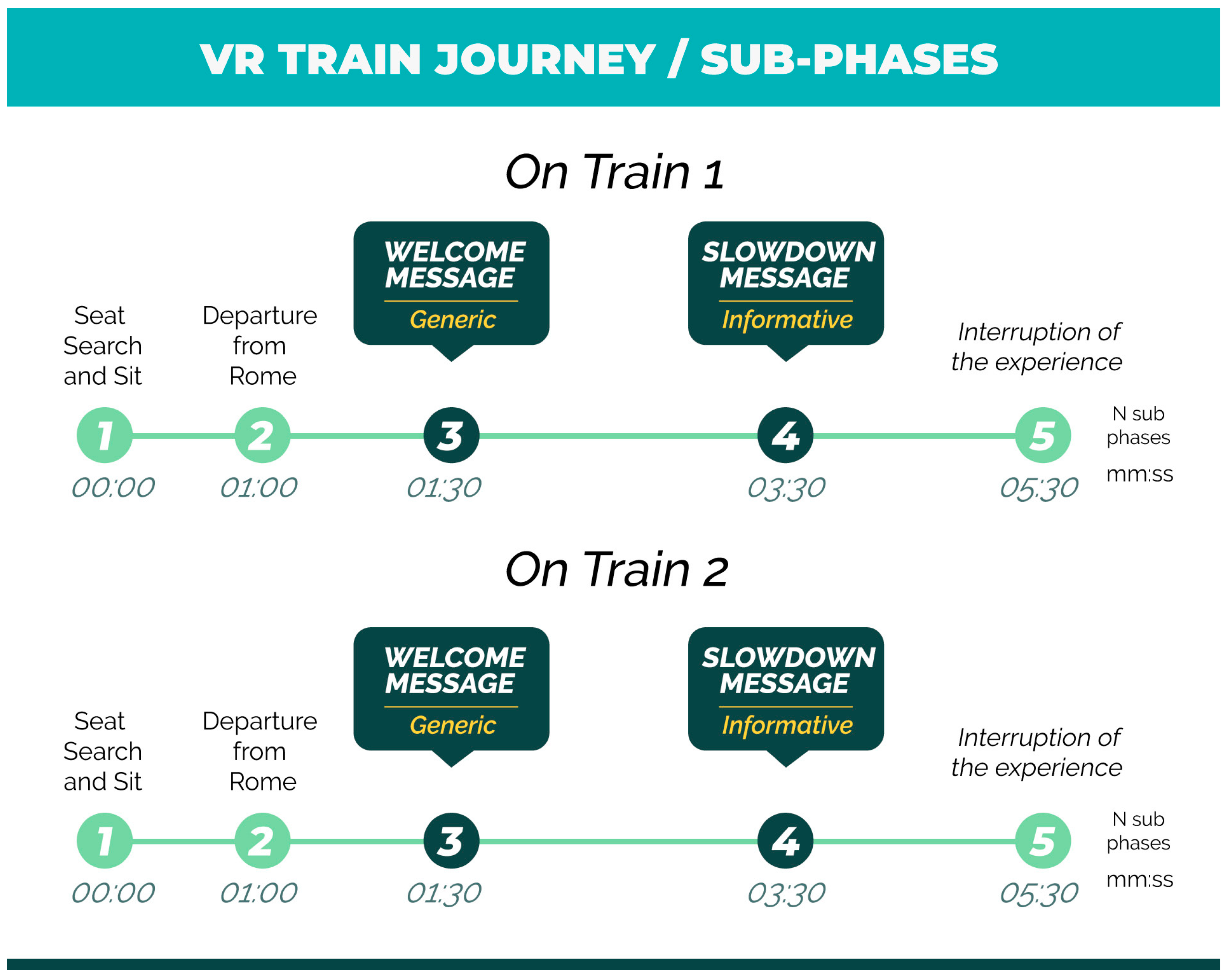



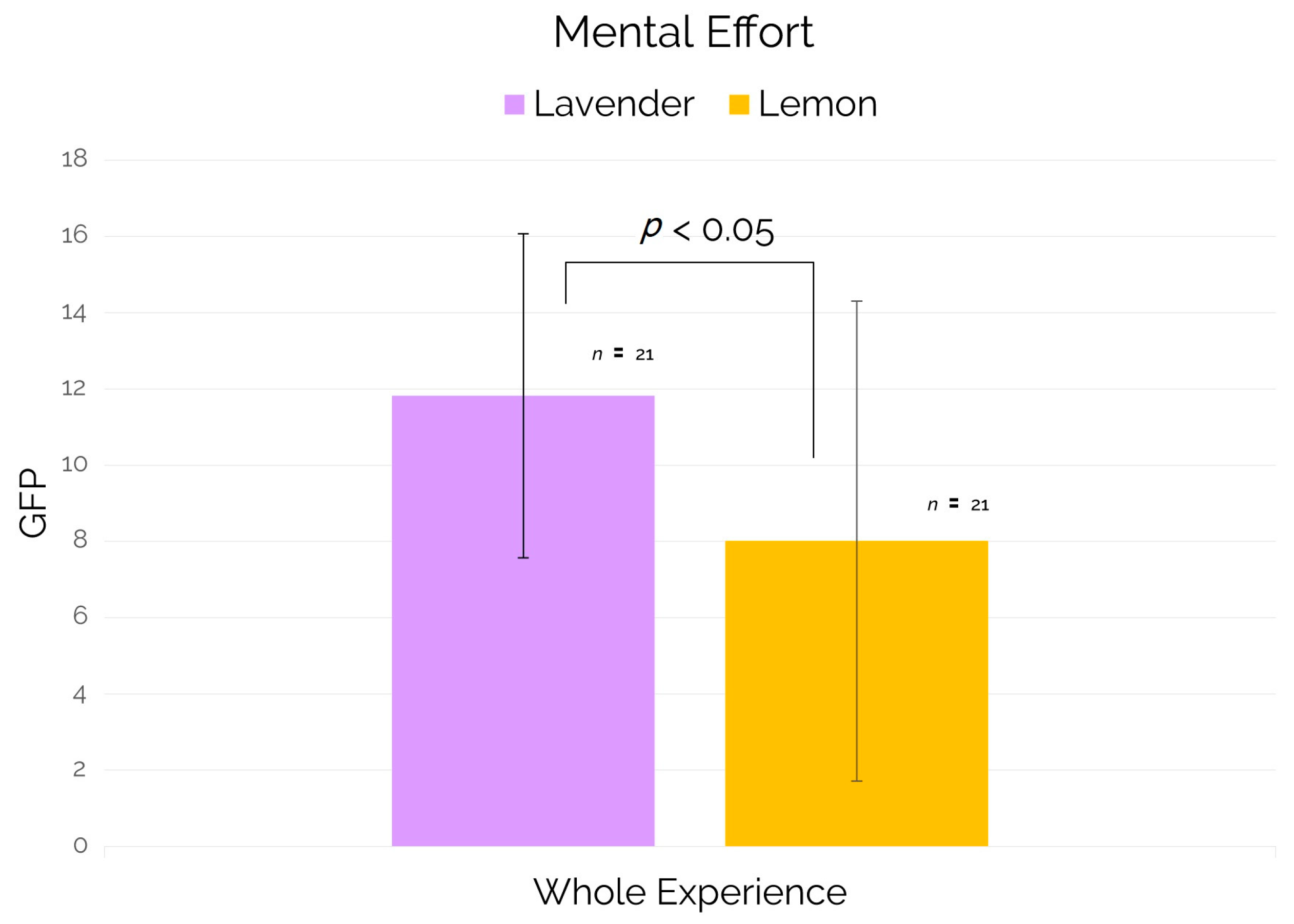
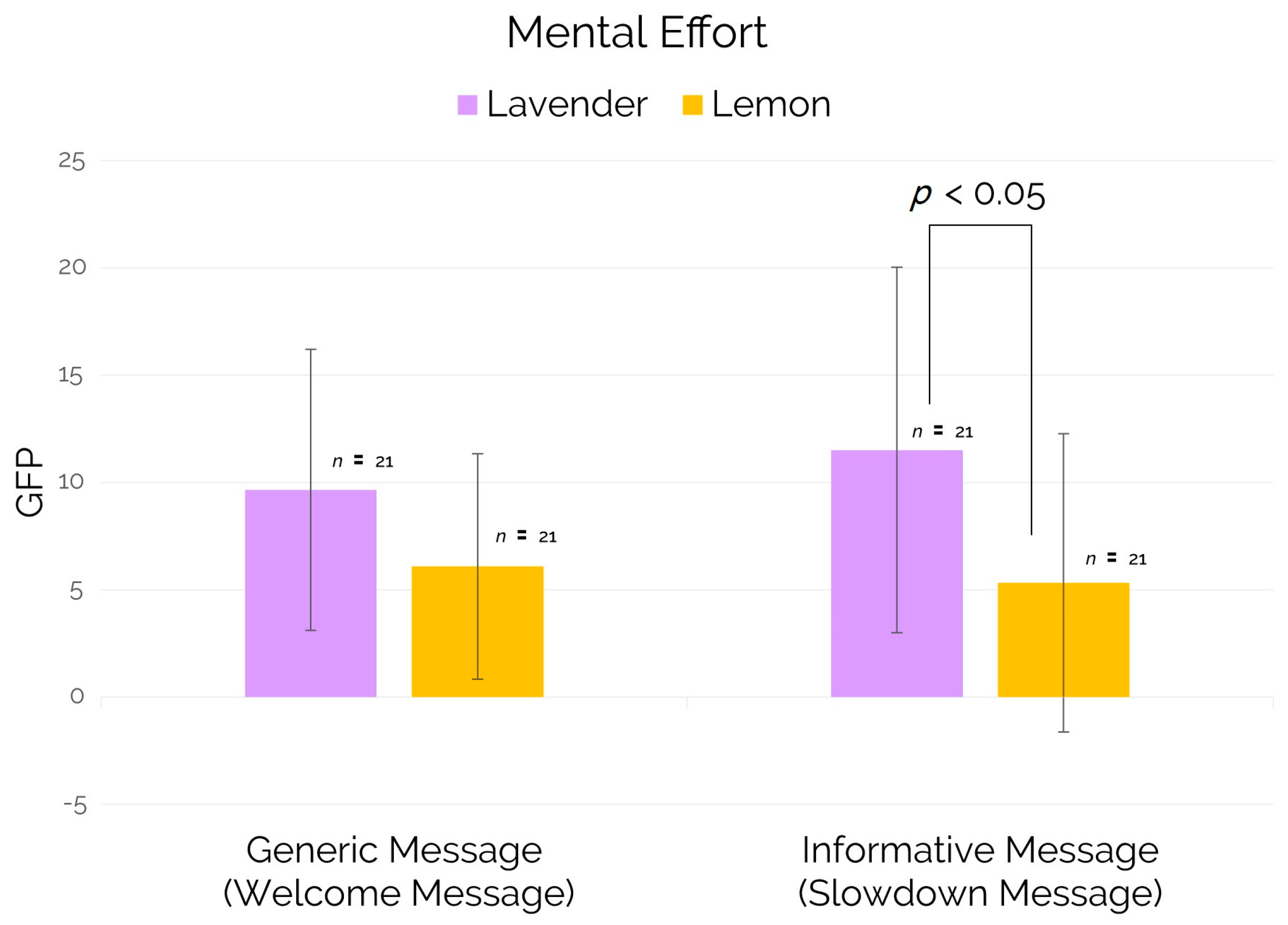

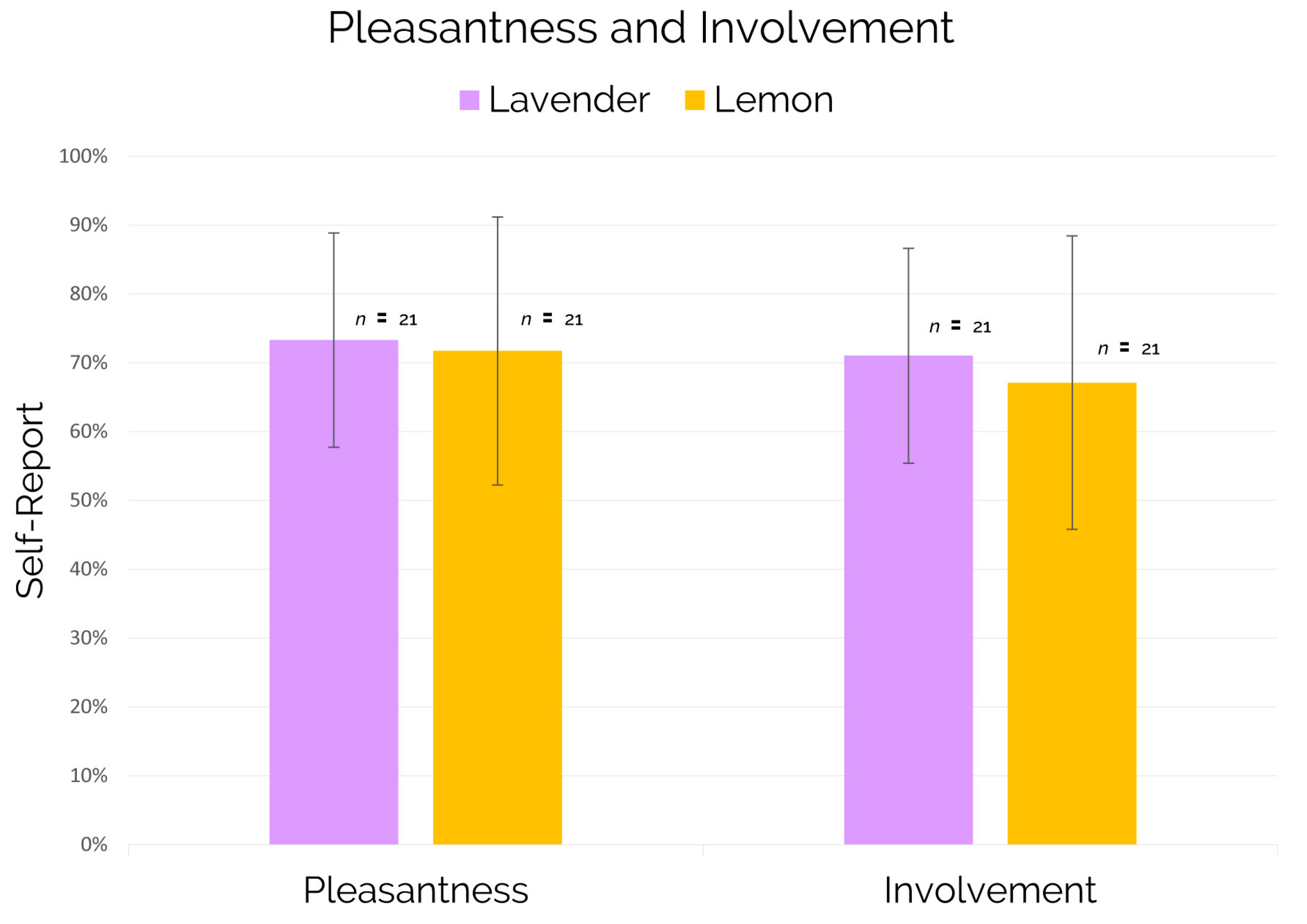
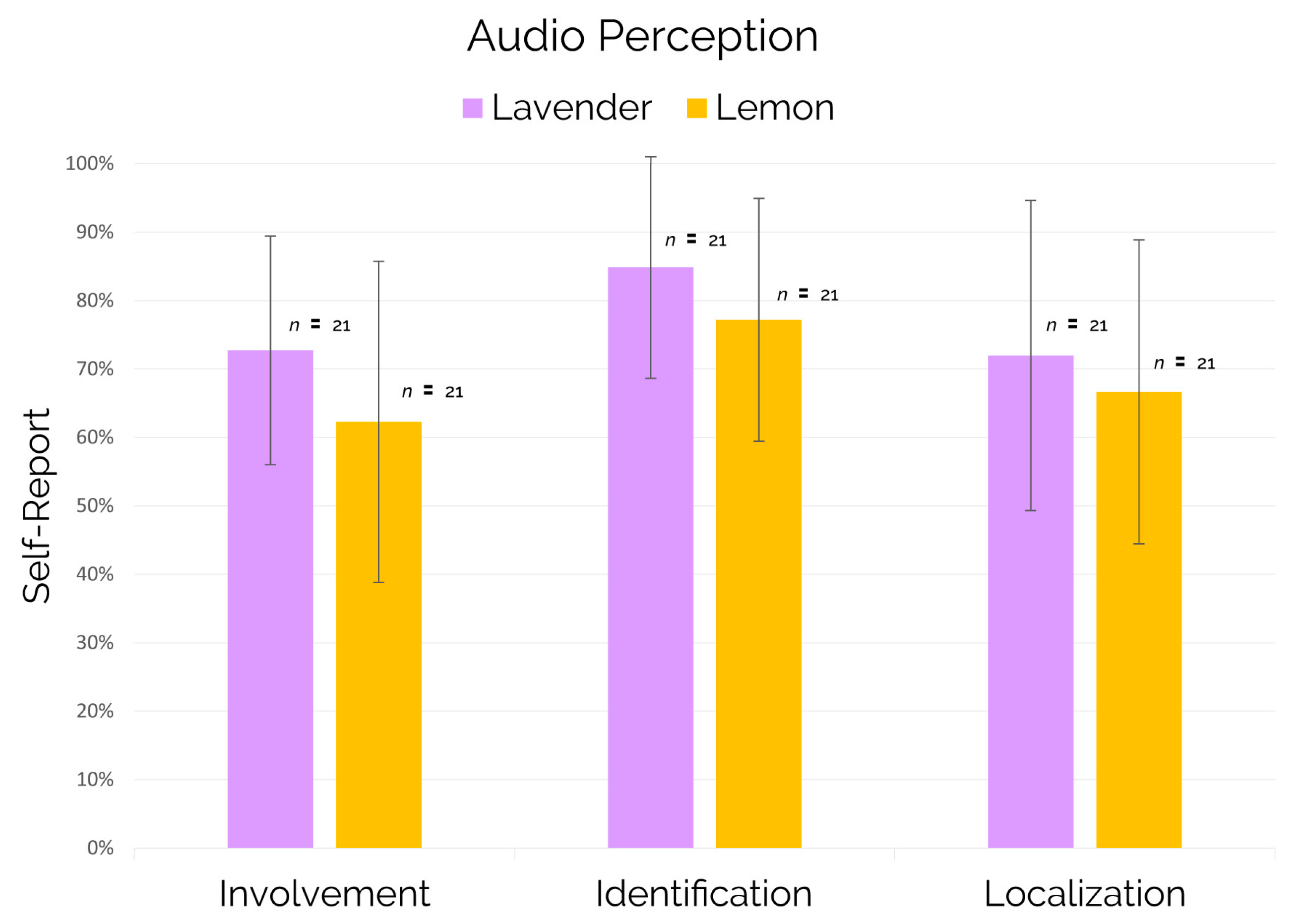
Publisher’s Note: MDPI stays neutral with regard to jurisdictional claims in published maps and institutional affiliations. |
© 2021 by the authors. Licensee MDPI, Basel, Switzerland. This article is an open access article distributed under the terms and conditions of the Creative Commons Attribution (CC BY) license (http://creativecommons.org/licenses/by/4.0/).
Share and Cite
Mancini, M.; Cherubino, P.; Cartocci, G.; Martinez, A.; Borghini, G.; Guastamacchia, E.; di Flumeri, G.; Rossi, D.; Modica, E.; Menicocci, S.; et al. Forefront Users’ Experience Evaluation by Employing Together Virtual Reality and Electroencephalography: A Case Study on Cognitive Effects of Scents. Brain Sci. 2021, 11, 256. https://doi.org/10.3390/brainsci11020256
Mancini M, Cherubino P, Cartocci G, Martinez A, Borghini G, Guastamacchia E, di Flumeri G, Rossi D, Modica E, Menicocci S, et al. Forefront Users’ Experience Evaluation by Employing Together Virtual Reality and Electroencephalography: A Case Study on Cognitive Effects of Scents. Brain Sciences. 2021; 11(2):256. https://doi.org/10.3390/brainsci11020256
Chicago/Turabian StyleMancini, Marco, Patrizia Cherubino, Giulia Cartocci, Ana Martinez, Gianluca Borghini, Elena Guastamacchia, Gianluca di Flumeri, Dario Rossi, Enrica Modica, Stefano Menicocci, and et al. 2021. "Forefront Users’ Experience Evaluation by Employing Together Virtual Reality and Electroencephalography: A Case Study on Cognitive Effects of Scents" Brain Sciences 11, no. 2: 256. https://doi.org/10.3390/brainsci11020256
APA StyleMancini, M., Cherubino, P., Cartocci, G., Martinez, A., Borghini, G., Guastamacchia, E., di Flumeri, G., Rossi, D., Modica, E., Menicocci, S., Lupo, V., Trettel, A., & Babiloni, F. (2021). Forefront Users’ Experience Evaluation by Employing Together Virtual Reality and Electroencephalography: A Case Study on Cognitive Effects of Scents. Brain Sciences, 11(2), 256. https://doi.org/10.3390/brainsci11020256








